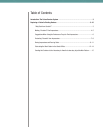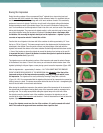
The wax pattern is ideal for obtaining records, as it was injected directly over the cast, and
therefore will fit (Figure 19). If the dentist desires, a post dam can be cut into the cast prior to
injecting. The wax pattern is also familiar and comfortable for the patient and provides a reference
to communicate to the laboratory, from which any and all changes are made predictably. The Celara
wax pattern is handled just like a wax rim. Base plate wax can be added to it, or it can be marked
and trimmed similar to a traditional rim.
Troubleshooting — Fabricating the Wax Pattern
• Avoid injecting too cool a temperature.
– This will result in a wavy wax pattern.
• Avoid injecting the wax too hot.
– This can result in excess shrinkage of the wax pattern.
• Avoid having the sprue hole too large.
– It will not make a seal in the inlet of the injector and the pattern may not fill with wax.
• Avoid having the inlet sprue hole too close to the ledge of the container.
– This will make it very difficult to place the container on the inlet of the wax injector.
• Avoid having the inlet sprue into the anterior teeth.
– The inlet sprue should enter the void above the anterior teeth in the anterior flange
of the denture. The anterior teeth and midline must be accurately represented in
the wax-pattern.
• Avoid injecting the alginate wet. Dry the alginate before injecting.
– The incisal edges of the anterior teeth will not be represented accurately if excessive
moisture is in the alginate.
• Avoid pumping the wax injector too vigorously —Pump very slowly and easily.
– This can shoot the wax out the exit sprue, which will make a mess and possibly
cause injury.
• Avoid removing the container from the inlet sprue of the container too quickly.
– Allow the wax to harden in the sprue before lifting the container off the inlet of the wax
injector. This prevents the wax from running out and creating a void in the pattern. The
resulting void will be in the distal of the pattern.
• Allow the wax pattern to adequately harden before removing it from the cast and
trimming to prevent distortion of the wax pattern.
14
Figure 19


















